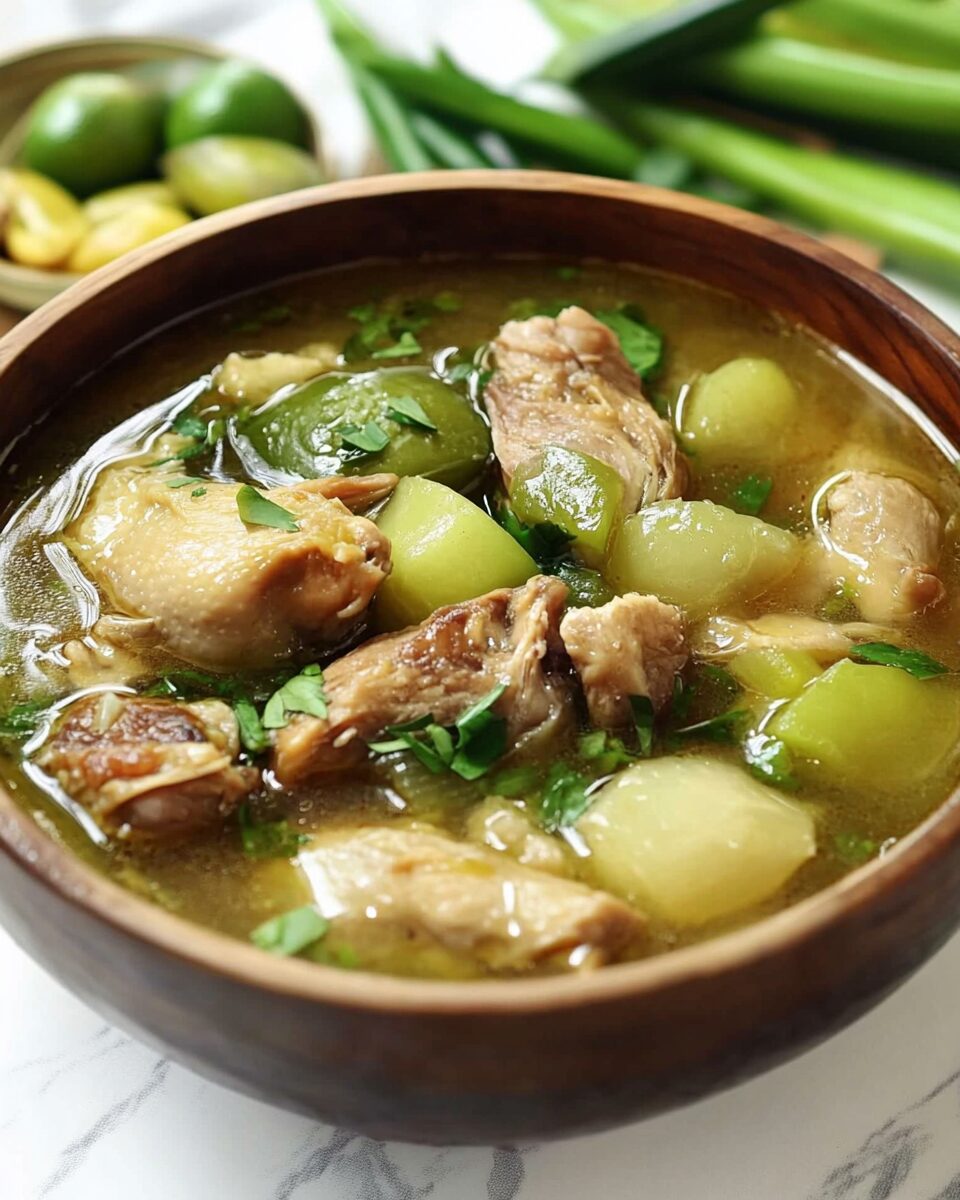Tinolang Manok is a nourishing and aromatic chicken soup from the Philippines, known for its delicate ginger-infused broth and wholesome ingredients. Green papaya, moringa leaves, and chilies add both depth of flavor and nutrition, making this a favorite household staple across the country.
This dish is perfect for cooler weather, soothing sore throats, or simply enjoying a taste of home. It’s easy to prepare, deeply satisfying, and pairs wonderfully with a warm bowl of rice. Whether you’re new to Filipino cuisine or grew up with this dish, Tinolang Manok offers a delightful and heartwarming experience.
Full Recipe
Ingredients:
-
500g chicken (cut into serving pieces)
-
1 tablespoon fish sauce
-
1 teaspoon black pepper powder
-
Salt to taste
-
750 ml chicken stock
-
1.5 cups green papaya or chayote (diced)
-
3 stems moringa leaves (malunggay) or chili leaves
-
2 long green chilies (siling pangsigang)
-
3 tablespoons oil
-
1 small onion, chopped
-
5 garlic cloves, chopped
-
2-inch ginger, julienned
Directions:
-
Heat oil in a saucepan over medium heat.
-
Add onions and cook until they turn a light golden brown.
-
Add garlic and ginger, cooking until golden brown and fragrant.
-
Add chicken to the pan and fry until the chicken turns a light golden brown.
-
Season the chicken with fish sauce, black pepper, and salt. Mix well.
-
Pour in chicken stock and bring to a boil.
-
Add green papaya or chayote and simmer until tender.
-
Add moringa or chili leaves and green chilies.
-
Simmer for another 2 minutes.
-
Serve hot with rice.
Prep Time: 15 minutes | Cooking Time: 30 minutes | Total Time: 45 minutes
Kcal: Approximately 275 kcal per serving | Servings: 2 servings
History and Cultural Significance of Tinolang Manok
Tinolang Manok is a classic Filipino soup dish that holds a deep connection to Filipino households and cultural identity. Originating from the Tagalog region in the Philippines, Tinola (the general term for this type of soup) has been enjoyed for centuries. Traditionally prepared as a nourishing and restorative dish, Tinolang Manok specifically refers to the version made with chicken (“manok” in Filipino), and it has been lovingly passed down through generations as a symbol of warmth, home, and care.
In Philippine literature, Tinolang Manok was even mentioned in José Rizal’s novel Noli Me Tangere, where it was served to important guests—an early indicator of the dish’s esteemed place in Filipino society. Over the years, the simplicity and flexibility of Tinola made it a staple in every Filipino kitchen, particularly appreciated during the rainy season for its warming and soothing properties.
Flavor Profile and Key Characteristics
What sets Tinolang Manok apart is its clean and subtle flavor, elevated by the combination of ginger, garlic, onions, and fish sauce. Unlike heavier stews or spicy soups found in other Asian cuisines, Tinola focuses on creating a mild but fragrant broth, highlighting the natural taste of its ingredients. The ginger provides a gentle spiciness that clears the senses, while the fish sauce adds depth and umami. The broth is light but richly satisfying, often served as a starter or a main dish with white rice.
The green papaya or chayote contributes a soft sweetness and absorbs the flavor of the soup, while the addition of moringa leaves (malunggay) or chili leaves adds both a slightly bitter note and essential nutrients. The long green chilies, although mild, give the broth a distinct aroma and can be adjusted to suit one’s preference for heat.
Nutritional Value and Health Benefits
Tinolang Manok is not just comforting—it’s also incredibly nutritious. It’s packed with ingredients known for their health benefits:
-
Chicken is a lean protein source that supports muscle growth and keeps you full longer.
-
Ginger has anti-inflammatory and digestive properties, often used in traditional medicine to soothe nausea and colds.
-
Moringa leaves, also known as the “miracle tree,” are a powerhouse of vitamins A, C, and E, along with calcium and iron.
-
Green papaya or chayote are rich in fiber and antioxidants, aiding digestion and promoting overall gut health.
-
Garlic and onions offer antibacterial and antiviral benefits, ideal for boosting immunity.
Because of this, Tinolang Manok is often recommended for people recovering from illness or seeking a lighter, nourishing alternative to heavier meals.
Regional Variations Across the Philippines
Though Tinolang Manok is widely prepared throughout the Philippines, regional adaptations give it unique flair. In Visayas and Mindanao, for example, the broth might include lemongrass or tanglad, offering a more citrus-forward flavor. Some households use native chicken (manok na tagalog) which has a firmer texture and deeper flavor, though it requires longer cooking time.
Vegetable substitutions are also common. Where green papaya isn’t available, chayote (sayote) is a popular replacement. Some families add sili leaves (chili leaves), spinach, or even pechay (Filipino bok choy). The choice of leafy greens often depends on what’s fresh and accessible, making Tinola a truly flexible, adaptive dish.
Why Tinolang Manok is Loved by Many
Filipinos love Tinolang Manok for its comforting simplicity. It’s not flashy or spicy; instead, it offers a wholesome taste that evokes feelings of family, tradition, and care. It’s a dish that’s both functional and flavorful—easy enough for busy weeknights, yet nutritious enough to serve to recovering loved ones.
It’s also a dish that’s deeply personal. Each Filipino family may have its own spin—perhaps a little more ginger, a splash of lemon or calamansi, or even adding rice directly into the soup for a porridge-like texture. This level of customization ensures that Tinola never feels boring, even if you’ve eaten it hundreds of times.
Serving Suggestions and Pairings
Tinolang Manok is typically served as the main course, accompanied by a bowl of steamed white rice. The neutral taste of rice perfectly complements the flavorful broth and helps absorb the delicious juices from the chicken and vegetables. Many people enjoy adding fish sauce or calamansi juice on the side to add a punch of acidity and saltiness.
If you’re looking to round out the meal, Tinola pairs well with other Filipino favorites like fried fish, lumpiang shanghai (Filipino spring rolls), or a fresh green mango salad with bagoong (fermented shrimp paste). A cup of warm salabat (ginger tea) also makes a great beverage pairing, especially during cooler months.
Modern Takes and Meal Prep Tips
Today, Tinolang Manok has found its way into modern kitchens, both in the Philippines and abroad. It’s popular among those who follow gluten-free, dairy-free, or low-carb diets. The ingredients are whole and minimally processed, making it a clean and wholesome option.
For busy individuals, Tinola can be made in large batches and stored for up to 3-4 days in the refrigerator. It also freezes well, though it’s best to store the broth and vegetables separately to maintain texture. You can also prepare a Tinola soup base in advance—sautéed aromatics and broth without the vegetables—then just add your fresh greens and papaya when reheating.
Some cooks have even turned Tinola into fusion dishes—think Tinola-inspired ramen bowls or Tinola-flavored chicken pies. While purists may stick with tradition, it’s exciting to see how this humble dish continues to evolve.
Cooking Tinolang Manok Abroad
One of the beautiful things about Tinolang Manok is its adaptability. If you’re living outside the Philippines, you can still make Tinola with easy substitutions:
-
Green papaya can be replaced with chayote, zucchini, or even unripe pears.
-
Moringa leaves may be found in international stores or substituted with baby spinach or kale.
-
Fish sauce is widely available in most Asian markets and is essential for an authentic flavor.
Even if you’re missing a few ingredients, the essence of Tinola—its ginger-garlic broth and comforting taste—can still shine through with thoughtful improvisation.
Conclusion
Tinolang Manok is much more than just a chicken soup—it’s a dish that embodies comfort, healing, and cultural pride. With its nourishing broth, simple ingredients, and versatile nature, it’s no wonder that this dish continues to be a cornerstone of Filipino cuisine. Whether you’re cooking for family, healing from an illness, or simply craving a warm, satisfying meal, Tinola offers both flavor and familiarity in every bowl.
For many Filipinos, it’s not just food—it’s home in a bowl. And for those new to Filipino cooking, Tinolang Manok is the perfect gateway dish: easy to prepare, rich in tradition, and endlessly comforting.
Let this humble, healthful soup bring warmth and nourishment to your table, wherever you are in the world.






